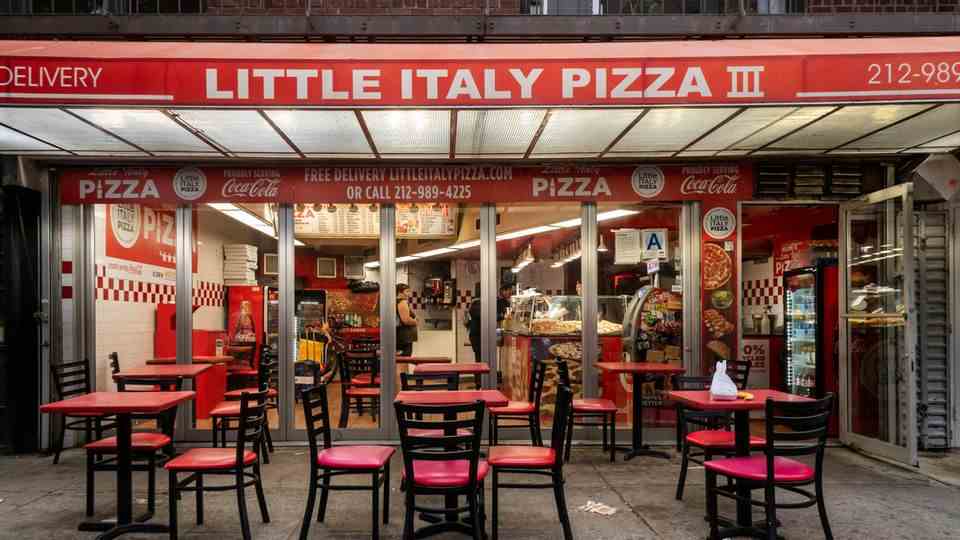Culinary Zoff
Carbonara, Pizza, Parmesan: Expert questions traditional dishes – and sparks anger in Italy
The ingredients for a classic carbonara are set in stone for traditionalists: pork cheek, Roman pecorino cheese, eggs and pepper
© Panthermedia / Imago Images
Are popular traditional dishes like pizza and carbonara “with their reputation for tradition and authenticity actually based on lies”? That’s what an article in the Financial Times asks. Yes, says food historian Alberto Grandi – and is then bombarded with criticism.
The most authentic Parmesan cheese is in Wisconsin, the world’s first pizzeria opened in New York, and spaghetti carbonara is actually an American dish too. In short, “Italian cuisine is really more American than Italian,” says Alberto Grandi, professor of food history at the University of Parma. With scientific evidence, the academic wants to debunk myths about supposedly traditional Italian food. In a country notoriously proud of its cuisine and striving to have it recognized as an intangible cultural heritage, his statements have sparked outrage and anger.
Carbonara, Pizza, Parmesan: Historical traces lead to America
“Everything I thought I knew about Italian food as an Italian is wrong,” Alberto Grandi said in an interview with the Financial Times. Many classic Italian recipes are therefore relatively new creations. The scientist’s findings could “destroy the foundations on which Italians have built their famous and notoriously inflexible culinary culture,” writes the British daily. Many of the foods for which Italy is recognized and celebrated around the world stem from the post-WWII era, when the country experienced an economic boom and cultural change, according to Grandi.
“When a community is robbed of its sense of identity as a result of historical shock or a break with its past, it invents traditions that function as founding myths,” explains the expert. The nation needed an identity that would help forget past struggles, while those who emigrated en masse to America at the time craved myths that honored their origins. In this context, it hardly seems surprising that “many preparations come from the history of the last 50-60 years and from interactions with the Atlantean culture”, the professor explains in the Italian daily “La Republica“.
Pizza, for example, could only be found in a few southern Italian cities before the war. There, what is probably the most popular Italian dish today was prepared and eaten by the underclass on the street. Research by Grandis suggests that the first restaurant to serve only pizza opened in New York in 1911, not in Italy.
Heated discussion in Italy
The carbonara, which is associated with the myth that it is a traditional dish of Italian charcoal workers, was invented in Italy – but not with Italian ingredients. A local chef is said to have first prepared the pasta dish for the US Army at a dinner in Riccione in 1944. “The Americans had fabulous bacon, very good cream, some cheese and egg yolk powder,” says Gualandi. Most experts agree on this story. As well as the fact that the oldest recipe for the carbonara was printed in Chicago in 1952.

Emigrants who moved to the USA, mainly from southern Italy, brought their supposedly traditional dishes with them. From America, some dishes – such as pizza – quickly gained worldwide fame.
© Levine Roberts / Imago Images
Another lead leads to the US state of Wisconsin, which the professor says is the only place where you can find real Parmesan cheese these days. The thousand-year-old specialty weighed a maximum of ten kilos in the original version, was surrounded by a black crust and had a fatter and softer texture. You can only find parmesan like this in Wisconsin these days, the expert said. This is probably due to the fact that immigrants from Italy have remained true to the traditional recipe, while the method of preparation in the country of origin has constantly evolved. Popular dessert “classics” such as panettone and tiramisu are only a few decades old – these two dishes are also commercial products invented by the food industry.
The scientist has already caused offense with his statements in the past. Among other things, he received criticism from the Italian ambassador to Turkey and from television presenters. This time the coverage made waves. “Through imaginative reconstructions, the most deeply rooted national culinary traditions are contested,” the “Guardians” Italy’s largest farmers’ association Coldiretti. The association is outraged by the “hypotheses about Parmesan and the Parmesan made in Wisconsin in the USA – the homeland of counterfeit ‘Made in Italy’ cheese.”
“We confuse root with identity”
“Experts and newspapers are jealous of our taste and our beauty,” says Matteo Salvini, deputy prime minister and leader of the far-right Lega. From the politician’s point of view, food and Italian cuisine have long been a symbol of national identity. For Alberto Grandi, on the other hand, it is an “identity dimension beyond all reason.” In the past, the “often obsessive pursuit of ‘authenticity'” as expressed by the “Financial Times“, has already caused absurdities a few times. The carbonara, for example, is characterized in the eyes of tradition advocates by a number of ingredients that always remain the same. Changing these can quickly meet with massive criticism. The same applies to many other pasta dishes.
New Unesco list
Baguette, rum and modern dance: these landmarks are now intangible world cultural heritage
In 2015, the city of Amatrice issued an official statement to correct Michelin-starred chef Carlo Cracco after he revealed he likes to add garlic to his amatriciana, a popular spaghetti dish. An ingredient that the original recipe allegedly does not provide for and was therefore benevolently described by the city as a “slip of the tongue”. “The point is that we confuse identity with roots,” says Grandi. He does not understand why his scientific evidence is so controversial. “I am reconstructing a historical and philological correctness of the history of these courts,” he clarifies. He never questioned the quality of Italian food or products.
Sources: “Financial Times“, “La Republica“, “The Guardians“



